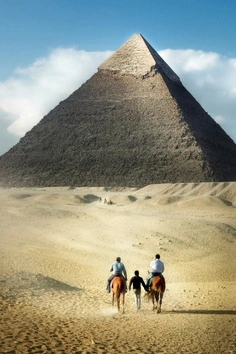
The pyramids of Egypt– Giza Plateau

The pyramids of Egypt– Giza Plateau
Cairo is a haven for cultural tours for children. If you want to arrange a trip for your children in Cairo, forget about parks, cinemas, circuses and seaside resorts and go for a tour in Medieval Cairo. It is much more fun, especially, if it is accompanied by a photo contest.
All photos here are taken by the children, except for two, I took them myself
It was 8am when we all gathered, both kids and their long-suffering mothers, at the Wonderland Mall in Nasr City. Our purpose? To take the rented tour bus to a series of destinations planned for the day. We were all on time. The bus driver turns out to be punctual, too, and by 8.30 we are off — to the mosques of Al-Refaai and Sultan Hassan near the Salaheddin Citadel, the Gayer Anderson Museum annexed to Ibn Tulun Mosque, and the Abdine Palace in, well, Abdine.
The children are excited about the programme; they’ve started to ask questions about the places we are going to. Assuming the role of tour guide, I’m doing my best to give the simplest possible answers. This is not my first experience of the situation, after all. It’s largely due to the success of last year’s trip to the Citadel, the Egyptian Museum and the Pyramids of Giza that we’re doing it again. And it’s not just about entertainment. This group of mothers share the belief that such a trip is as important for their children as school curricula — and less trying.
It all started when my son, Adham, turned eight; in the course of a casual conversation it dawned on me how little he knows of Egyptian history: in the winter he does his school work; in the summer he plays by the sea. Ah well, I thought, remembering my own history with dread. Forget the last 17 years of my life, during which I’ve been a professional travel writer. The first time I set foot in the Egyptian Museum I was, erm, 21 years old. Nor did I even see Khan Al-Khalili until my first year as a travel writer: the foreigner who accompanied me, then, knew so much more than I did it was terribly embarrassing. Never! I cried inwardly, looking into Adham’s eyes. And so I started an Egypt-wide plan covering Pharaonic, Coptic, Islamic and modern. Initial exploratory experiments revealed that, individually or in small numbers, children have the tendency to get bored. The answer? Take the whole class, preferably with parents, and visit more than one place and period at a time.
The mothers of Adham’s classmates proved universally enthusiastic — and helpful. A task list was quickly drawn up and divided among us: planning the route, renting the bus and preparing an info sheet was my responsibility. Sherine compiled material about the architecture; Noha took on the formidable task of coordination, not only of times and venues but costs.
The itinerary was tailored to the children, with the idea of maximum absorption as our guiding principle: at the Citadel, for example, the Mohamed Ali Mosque would serve as an introduction to Islamic architecture while offering stimulating surroundings and plenty of space, while at the Egyptian Museum we headed straight for the King Tut’s glittering mask. Following the Pyramids, Andrea’s overlooking the nearby Marioutiya Canal matched the mood with its authentic — and very tasty — Egyptian cuisine.
Lessons learned included making the next trip shorter — and, on the present occasion, I chose sites closer together. I concentrated on Islamic monuments and royal history: aside from the excitement of Al-Refaai’s interior, we visited the tombs of the Egyptian royal family and the shah of Iran. Then we moved on to the mosque in the Madrassa Mosque of Sultan Hassan — one of the biggest domes in the world. And only 15- minute drive brought us to Beit Al-Kiritliya: Gayer Anderson Museum, perhaps the truest model of a middle-class Cairene family home in Mameluke times, later acquired by the British officer-collector whose name it now bears. At the Abdine Palace we saw not only royal possessions but gifts given to President Hosni Mubarak by heads of state. The tour came to an end at the famous Felfela’s, not far from Abdine. Here too the food was rich, varied and in the spirit of that day.
This time we managed to make the trip even more interactive by organising a photo contest, choosing the best three from the whole day. Those who didn’t have a camera used their mothers’ mobile phones; and it was clickety- click all along. Most, in fact, took excellent photos. It was next to impossible to choose three, so we decided to enlarge and display them at their School. Alongside the photos were the kids’ impressions.
Despite political turbulence in Egypt, Egyptian hotels are preparing for an unforgettable Valentine’s night activities for Egyptian and foreign travellers.
Four Seasons Hotel Cairo At The First Residence in Giza offers a Bed and Breakfast package, dinners for two and sweet Spa treatments.

You can choose between several dining options at The Four Seasons Cairo
Photo: Four Seasons Cairo At First Residence
For LE1200 per night, a guest can enjoy a luxurious accommodation in a superior room, breakfast for two, surprise Valentine’s amenities and 50 percent off parking fees.
Dinner options are various on that special night. For LE500 per person, inclusive of service charge and taxes, guests can choose from the menu of Seasons Restaurant or that of Lai Thai Restaurant. At Seasons, a guest will enjoy the four- course menu of executive chef Erwan Laurenceau, which begins with a lobster amuse – lobster ravioli with a lemongrass infusion sauce – followed by mouthwatering roasted sea bass, herb potato crust and young vegetable fricassee. The third course is lamb cannon and smoked potato calisson with an olive and tomato crumble. For dessert, Seasons presents a chocolate tulip flower, chocolate and ginger dome topped with a silky strawberry sauce.
Those who prefer a taste of Asia can head to La Thai restaurant, whose Valentine’s menu includes mouthwatering items such as prawn satay, grilled beef salad with roasted rice, sweet and sour soup and a variety of delectable main courses such as grilled jumbo prawn, chicken roll with lemongrass and penang curry sauce, and stir-fried mussels with chili and Thai ginger. For dessert, you can get a delicious pink water chestnut-ball in coconut milk.
For an intimate Valentine’s pampering session, guests can book Hot Coco Romance at the Spa. This special two hour experience includes a chocolate covered massage – a natural aphrodisiac designed to leave skin soft and smooth, followed by a facial cleansing. Alternatively, the Sugar Rush treatment featuring a brown sugar body polish followed by a deep full body Balinese massage is another sweet treatment perfect for Valentine’s Day.
To conclude the Spa experience, guests can indulge in some romantic time together with lavish chocolate treats, delicious strawberries and a glass of bubbly in the private Nile-view couple’s suite.
The Hot Coco and Sugar Rush Spa treatments are each priced at LE 1250.00 per person or LE 2500.00 per couple and include a romantic setting, strawberries, chocolate and red roses.
For reservations call Hotel directly at 02-3567 1600.
InterContinental Cairo Citystars and Holiday Inn Cairo in Heliopolis are two other venues for a perfect Valentine’s Day. In InterContinental Cairo Citystars, you can enjoy a set menu at Al Bustan Grill accompanied by love songs from 6pm until midnight or you can sip special Valentine’s cocktails on the hotel’s ‘couples only night’ at Bellini Cocktail Lounge with a beautiful rose provided for the occasion from 7pm to midnight.
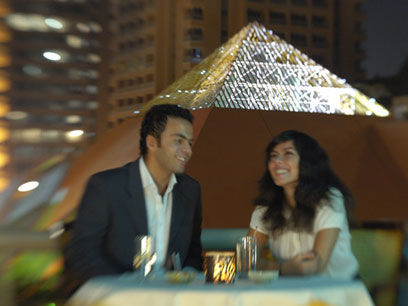
Enjoy the variety of food and activities at InterContinental Citystars Hotel
Photo: InterContinenal Citystars Hotel
Guests can also head to the buffet dinner at Esplanade Café Restaurant from 6:30pm to 11pm, or enjoy a Lebanese Valentine’s at Fayruz, where a welcoming cocktail, candles, roses and belly dancer create a unique glowing atmosphere
If you are for fine dining, then Maestro is the place. On the Valentine’s, in a special setting of heart shaped balloons, red napkins, candles and roses, guests will enjoy a sumptuous six-course set Italian menu, and a heart-shaped cake accompanied by piano tunes.
If you want an untraditional celebration, Windows at Holiday Inn Cairo Citystars provides a ‘live cooking’ buffet from 2pm to 11pm, while the Indian restaurant Indira sets the scene beautifully amid candles and red flowers for a memorable set menu occasion.
Valentine’s will not only be celebrated in Cairo, Alexandria hotels also have their own way to celebrate the occasion. For only LE300 per person, Sheraton Montazah Hotel offers guests a luxurious accommodation in a brightly decorated room overlooking the Mediterranean and the historical Montazah parks.
In addition, guests can also enjoy sauna and body treats and live night entertainment. Guests can indulge in the Valentine’s gala party and dinner at Caesar Bar where romance begins with the love songs of the duo Sameh and Soha, followed by a mouthwatering menu.
If you want to spend a calm Valentine’s, you can pamper yourself with an energizing experience at the Fitness Center enjoying a rejuvenating sauna or a relaxing massage using premium oils.
Special discounted rates in Sheraton Montazah Hotel for the readers of The Road to Kemet blog.
It is difficult to imagine what it must be like to be a blind tourist; to see a country through touch, sound and smell. Yet, this is exactly what a group of blind German tourists did, several years ago, travelling from Cairo to Fayoum, Wadi Natroun and Upper Egypt.
“We always use the word ‘see’ when we describe something,” explained Carla Arning, the group organizer, who is specialized in tourism for the blind and the visually impaired. The verb used in this way means to get an impression of things through the other senses,” she said.
Wherever the group went, they would all listen very carefully to what the tour guide had to say before having their hands guided to the object described so as to trace its outlines with their fingers. When the monuments were too large to gauge by touch, as in the case of the alabaster sphinx at Memphis for example, they were given small reproduction statues to explore its shape.
“The blind have a right to travel and enjoy life, like any other people,” said Arning. “They should not be kept in dark rooms because they are blind, and nor should they be kept in the dark about other cultures.”
Arning has devoted her life to working with the blind. She explained that she is not paid for her work, feeling that God gave her special gifts to communicate with others and that it gives her pleasure to use these gifts.
Judging from the reactions of the 20 member group, Arning’s work is a great success. The group enjoyed every place they went to and felt that they had absorbed a great deal about the culture of Egypt.
“I was fascinated by Sakkara- the wide area, the many tombs, and the ability of the workers in ancient times to build such fantastic tombs with such wonderful paintings,” said Doris.
“I loved the Pyramids and the quarry and the unfinished obelisk in Aswan,” said another. “It is the contrast between the green and the brown, i.e., between the desert and the fields in Upper Egypt which attracted me most,” said a third.
The group spent a week in Cairo where they visited the Citadel, the mosques of Mohamed Ali, Sultan Hassan and Ibn Tulun, as well as Khan El-Khalili. They also went to Giza, Memphis and Sakkara. In Fayoum, they went to Lake Qarun, and then to the monasteries at Wadi Natrun. Finally, they spent a week on a Nile cruiser in Upper Egypt, where they visited Luxor, Aswan, Kom Ombo, Edfu and Esna.
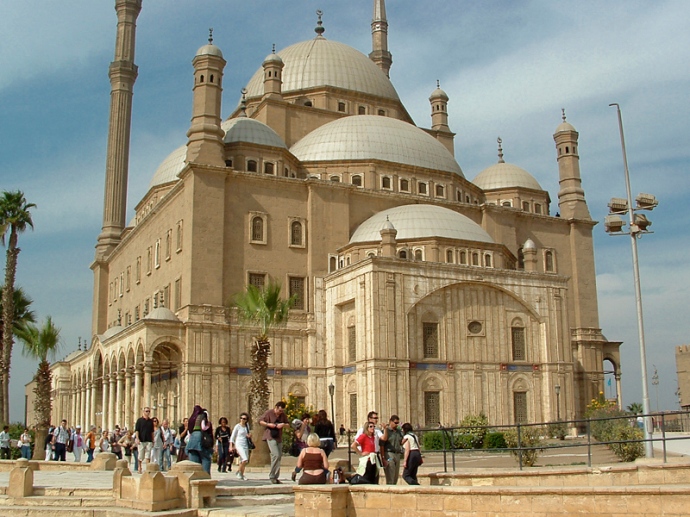
The Citadel
http://www.famouswonders.com
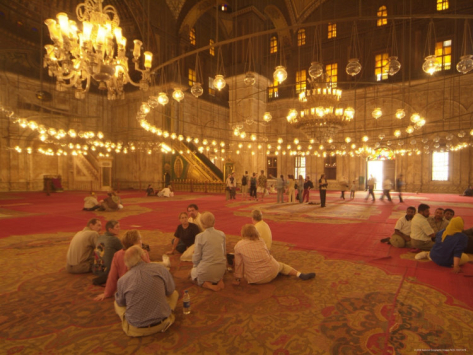
Mohamed Ali Mosque
http://www.art.com
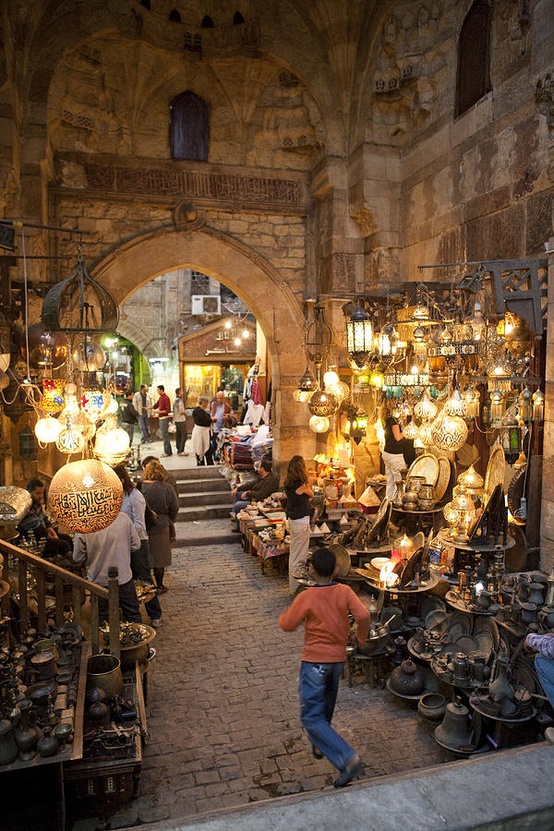
Khan El Khalili
http://www.fineartamerica.com
At Sakkara, the group visited all the places which are on the regular tours. They “saw” Zoser’s Step Pyramid, Unas’ pyramid, the tombs of Mereruka and Ptah- Hotep. Before entering the tomb of Unas, a king of the Vth dynasty, the tour guide, Ziad Anwar, read some of the pyramid texts inscribed on the walls of the burial chamber. They were believed to have magical powers and were written by the priests to ensure that the deceased would overcome all difficulties in the afterlife. Reading some parts of the text before entering the burial chamber prepared the visitors for the hieroglyphic inscription they are going to touch inside. Inside the tomb of Mereruka, they touched the reliefs which depicted life of ancient Egyptians: their clothes and their children’s games.
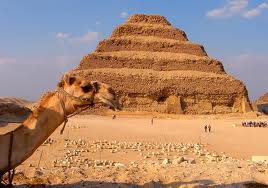
Zoser’s step pyramid at Sakkara
http://www.treklens.com
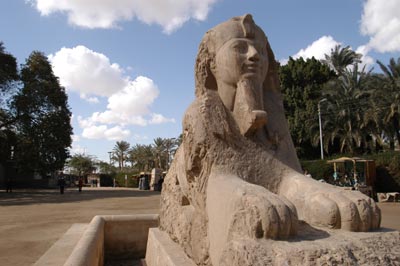
The alabaster Sphinx at Memphis-Sakkara
http://www.ghandoury.wordpress.com
The group was equally impressed by the Islamic monuments they visited. During their visit to the Mohamed Ali mosque, they admired the charming Turkish Baroque ablution fountain which, in its individual and collective features, they were able to compare with similar sabils of the Mohamed Ali dynasty around Cairo. They also touched the magnificent marble cenotaph which marks Mohamed Ali’s resting place as well as the minbars (pulpits) in the mosque, the larger one of wood decorated with gilt and the smaller one of alabaster, a gift from King Farouk in 1939.
Each blind visitor was accompanied by a sighted companion who helped him or her throughout the trip, sometimes explaining places where they passing on the way. These companions were sometimes relatives, friends or colleagues of the blind people and sometimes volunteers.
One companion described the experience: “It is very different from touring alone. I have to describe everything I see. The problem is not only to guide the blind but to try to describe things to them all of the time,” said Martin Roth, a student from Goettingen.
“The difficulty,” said another,” is that you have to be attentive all of the time. However, I think I gained considerable experience in describing things.”
Most of the visitors in the group not blind from birth- but later lost their site. This facilitates the task of the guide to some extent, as they are able to imagine the shape and the colors described.
Erika Knoop, a telephonist, has partial sight. “When I touch any monument I can imagine it,” she said. Petra, a teacher from East Berlin, also talked about the impression she can get of an object by touching it. She can tell the size of a statue from simply touching its foot or leg. “One or two touches are enough to imagine how big it is,” she said.
Some of the group was already well-travelled. Ortwin Eileors, a telephonist in Hildesheim, for example, has already been, among other places, to China and Florida. “Every country is different from the next,” he said, “The taste, the smell and the noises are different.”
“From the sounds I could hear I would feel that Cairo is both crowded and noisy. However, I also get an impression that its people are very friendly,” said Doris.
Doris was accompanied by Gerd, who is partially sighted. “My problem is how I can lead the blind while I am partially sighted myself. But I think it is a bit easier in a group,” he said. “In a group I won’t get lost because there is always someone looking for us,” he added.
Most of the companions on the trip expressed their willingness to do the job again, especially with people they knew already. “I wouldn’t do it with just anybody because that would be extremely difficult,” one companion said.
These tours are obviously tailor-made for the blind. “We have a lot more colors and more detail in our explanations,” said Arning. “Our tours are not done in a hurry. We spend a longer time at each site than other groups.”
Ziad, the tour guide, mentioned the importance of measurements. “A blind person will not understand terms as ‘big’, ‘small’, ‘high’, ‘low’. Actual measurements have to be used instead.
According to Arning, sighted people, who often care about pictorial images, miss out on a lot that the blind pick up on.
A special trip was also made to the Kalabsha temple, which is rarely visited by tourists. They chose to go there because it is generally empty and gave the group the chance to touch as much as they liked. It also enabled them to get acquainted with the shape of the temples, the inner sanctuary and the open court yard. Kalabsha was a sort of an introduction in the explanation of other temples.
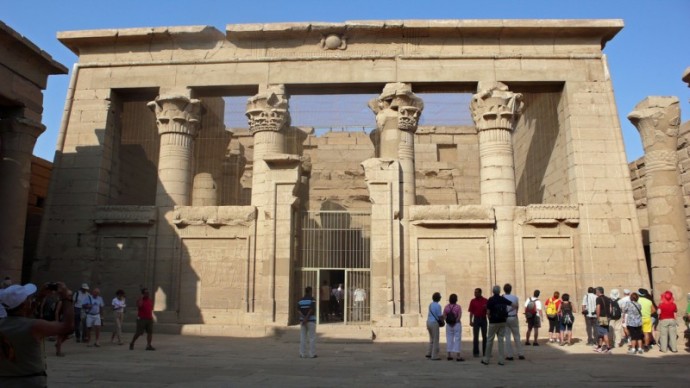
Kalabsha Temple
http://www.memphistours.com
There were some problems which faced the group. The first was in the Egyptian Museum where the tourists were only allowed to touch statues made of granite and diorite. “It is always a problem in my trips and it is always frustrating,” said Arning. “We are allowed to touch everything in all of the museums in the world, including the Pharaonic monuments, but in the Egyptian Museum there are restrictions,” she said.
Another problem was on the cruise in Upper Egypt, when the group complained about the music of the parties they attended. “The blind have sensitive ears and they could not stand the level of the noise,” says Arning.
Arning is on the opinion that it is better to have a small group, not exceeding 25, on such a special tour, because this gives the travellers a chance to enjoy themselves, and to take things at their own speed.
A group of deaf tourists from Germany might not have been able to hear about the wonders of Egypt, but with a little indulgence, a tour guide helped them out.
During the day, tour guide Ziad Anwar faced the sun. In closed areas and at night, he lit his mouth with a torch.
The tourists asked him to shave off his moustache. They would then be able to read his lips with ease. He did.
This was Anwar’s first such experience. “Dealing with any handicapped tourist is difficult,” he says. “It requires a lot of preparation and a special way of dealing.”
Twenty-five deaf German tourists spent two weeks travelling through Cairo, Giza, Luxor, Aswan and Sinai and Ziad Anwar was their guide. Organized by a German association for the deaf, the group was made up of people who had once been able to hear.
Knowing that he wouldn’t be easily understood, Anwar printed a booklet describing the monuments and places they would visit, and distributed it on the first day of their trip. “I also had to talk slowly in German, clearly and in simple language,” he says.
But he wasn’t on his own. The group’s tour leader from Germany assisted Anwar in his task, translating his words into sign language, and some of the tourists wore hearing aids.
In the mornings, Anwar and the tour leader would go door-to-door, with the help of master keys, “because they could not hear the wake-up call,” he says.
Crowds also presented a problem. Once, some of the tourists got dispersed; “They couldn’t hear me so I ran after them and tapped them on their shoulders,” he recalls, and he directed them to the rest of the group.
During the group’s climb up Mount Sinai, Anwar hired someone to walk at the front while he remained behind, making sure the group stuck together.
These are among the preparations made by Anwar who had once before hosted a group of blind tourists. They, in turn, had taught him about the importance of using vivid, detailed, verbal descriptions of each site. “Patience is the keyword when dealing with handicapped people,” he stresses.
Anwar was not entirely savvy with the group of deaf tourists, however, and had some myths of his own to break. On the group’s Luxor-Aswan cruise, he thought they wouldn’t enjoy the galabiya party because they wouldn’t be able to hear the music. But they danced from the beginning to end, moving to the vibrations their bodies felt as loudspeakers blared the music.
And then there were some misunderstandings that were just laughed off: When the group stood at the gates of Medinet Habu on the west bank of the Nile in Luxor, Anwar said the word “Habu.” Someone responded, “Oh, we’ll have some,” referring rather to “hamburgers.”
But he does feel that he’s developed a certain knack with tourists who require a different type of tour and has noticed some surprising differences. On the normal tour, he says, the bus is always quiet and the guide does the talking. In the case of the deaf group, he says, “The guide doesn’t talk at all and the tourists chat with one another (by moving their lips and uttering sounds in the process). They speak in very loud voices and the bus starts to resemble a marketplace.”
Tourism for the disabled is not yet developed in Egypt but Anwar feels that it has a great potential. He suggests that specially trained tour guides, documentary films, photos, video tapes and other aides be made available to tour guides like himself.
Now, if there are any disabled people in groups, he feels “an affinity towards them” and tries to make their trip even more enjoyable than might be expected.
In the first full excavation of the dog catacombs at Saqqara, Salima Ikram, professor of Egyptology at The American University in Cairo (AUC), along with an international team of researchers led by Paul Nicholson of Cardiff University, has estimated that approximately 8 million animal mummies are present at the burial site and is working to establish whether different breeds are represented there. “We are recording the animal bones and the mummification techniques used to prepare the animals,” said Ikram. “In doing so, we hope to identify the dog breeds present at the site. Thus far, our bone measurements indicate that there are different breeds that were mummified there.” The mummified animals at Saqqara are not limited to canines. “There are cat and mongoose remains in the deposit,” explained Ikram. “We are trying to understand how this fits religiously with the cult of Anubis, to whom the catacomb is dedicated.”
For Ikram, one of the world’s preeminent scholars in the field of mummification with a specialization in archaeozoology, the study of animal mummies offers deep insights into ancient Egyptian culture. “Animal mummies are really manifestations of daily life –– pets, food, death, religion and technology. They cover everything the Egyptians were concerned with,” said Ikram, adding that when Egyptology was becoming established as an academic discipline in the 19th century, archaeologists pushed past hundreds of thousands of animal mummies in their haste to uncover the human ones and, more significantly, their grave goods.
Salima Ikram on site at Saqqara
The dog catacombs research at Saqqara, funded by National Geographic, is one of several archaeological field projects in which Ikram is involved. She directed the Animal Mummy Project at the Egyptian Museum, resurrecting a neglected exhibition that first caught her attention when she visited the museum as a child. In addition, in Project Djehuty, directed by Jose Galan and which focuses on the excavation and restoration of tombs T11 and T12 in the Dra’ Abu el-Naga necropolis in Thebes, Ikram sees great potential for her work with animal mummies, combined with the efforts of other specialists, to yield revelations about ancient Egyptian life. “This project is the first time that an area like this has been examined so holistically,” she said. “While I study the animal mummies, there are others in the group studying the texts written on the walls by the same people who embalmed them. By studying everything from textiles to text to animal remains, we can elucidate quite a bit about what these people thought, their religion and the economic effects of mummifying hundreds of thousands of animals.”
Discoveries have shown that there are four main reasons ancient Egyptians mummified animals. “They were mummified as sacred creatures that were representative of the gods, as beloved pets, as gifts to the gods and as food for the afterlife,” said Ikram, explaining that these varying motives reveal much about the behavioral patterns of the ancient Egyptians. She added, “Using DNA testing of mummified ibis remains found in geographically different locations, we hope to establish isolated breeding groups. An abundance of recessive genes showing, for example, would indicate interbreeding of animals in captivity. This also signifies something of an economy of breeding animals for mummification.”
For Egyptologists, mummies reflect everything, from the sacred to the suspicious. “Animal mummies were a very visceral and organic way for people to communicate with the gods,” Ikram said. “At the same time, they were also a business, and many of the mummies I’ve studied are ancient false mummies -– a fragment of an animal wrapped as if it were a whole one, or an interior containing nothing but mud. Maybe the Egyptians thought that the intention was sufficient for divine communication.”
Whether it is dogs in Saqqara or ibises in Thebes, Ikram sees familiar human motives at the heart of animal mummification. “You look at these animals, and suddenly you say, Oh, King so-and-so had a pet. I have a pet. And instead of being at a distance of 5,000-plus years, the ancient Egyptians become people,” she said.
This was the first story ever to write in my whole life. It was published in Al Ahram Weekly newspaper in May 1991, only few months after the end of the second Gulf War. I chose to write about Nazlet El-Samman because I used to work there for few months after I graduated from University. For me, it was a totally exclusive experience. It was a place that was completely different from the place I live in. I saw a whole community dedicated to one profession, namely, tourism. I saw families who have different customs and traditions from other places in Egypt; families who know each other and form one big community. Here is the story:
A community of shop owners, horse owners, cameleers and fake statutes at the foot of the pyramids
The inhabitants of Nazlet El-Samman live at the foot of the pyramids of Giza. They have a long history of service to tourists and they desire to continue to ply their trade.
“A man called El-Hefnawi was once famous for being able to climb the great pyramid in seven minutes, and a cameleer called Lamea owned a camel of worldwide fame; it was called Canada Dry and people came from far and wide to ride it,” said Zahi Hawwas, director of antiquities of the Giza Plateau (the then minister of antiquities in the last cabinet in Mubarak’s era and also in the first cabinet after the revolution).
Such stories are also told by members of the community situated beside one of the most famous sites in the world, the pyramids of Giza. The settlement was named after Sheikh Hamad El-Samman who settled there in the 7th century; he devoted himself to worship in one of the ancient Egyptian tombs on the necropolis belonging to an official called Debhen who lived in the time of Menakaure, builder of the second pyramid.
Today the settlement has expanded and some 70,000 people live in Nazlet El-Samman. They are the people who serve an estimated 3,000 tourists who visit Giza daily in the peak season. They own the horse stables, they are the cameleers, and they are the traders who own numerous papyrus galleries, oriental bazaars, and kiosks that sell “instant antiquities” in the area.
Selling fake statues is one of the professions of the residents of the area
“Not all of our people are educated,” said Atef El-Gabri, the owner of a perfume shop. “But from our contact with foreigners we know a variety of languages…in fact we consider it our duty to communicate in the tongues of all the visitors who come to Giza.”
So successful is the community that sons tend to follow in the footsteps of their fathers in various trades and “some of our children who became doctors, engineers and graduates in other fields have left their profession and joined us to work in the field of tourism,” explained another resident. “Many do the necessary training and also act as guides.”
In Nazlet El-Samman there are about 100 shops and papyrus galleries, as well as about three times as many carpet shops as there are at Sakkara. The traders do a thriving business on cleverly manufactured fake statuettes, and a large variety of gold and silver jewellery is also on sale.
“Would you like to have your name carved on a cartouche?” is a frequent appeal to tourists; or “Come and look…no charge for looking!”
Horse stables at Nazlet El- Samman
In Nazlet El-Samman, the tribal identity is strong. The inhabitants are of Arab stock; that is to say they are desert people, not Nile Valley dwellers, and they first came to the area in large numbers when the Mena House Hotel was built around the turn of the century.
“We were brought in with our horses to provide services for tourists wishing to ride around the pyramids. Later we built our own stables, and they are now 15 in the area.”
The area is characterized with large families which are closely attached to each other; there are clans that go by such names as Khattab, El-Gabri, El-Shaar, Fayed, El-Komati, Abu- Ghounan, Abu – Ghanem and Abu Talib. Members of each clan tend to intermarry and weddings are a great celebration, when animals are slaughtered for a great feast, drums like the tabla baladi announce the happiness of the families, and horse dancing is part of the festivity. Foreign visitors are always welcome at such occasions.
Camel riding at the Giza Plateau
The celebration of the birthday, or mulid, of the local Sheikh is another festive occasion. It takes place in September, and always falls on a Wednesday or Thursday. “It is like a great feast,” said Samira, another resident of the area. “There is great concern for new clothes, for swings and entertainment for the children, and also sweets, halawet el-mulid. Each house celebrates the occasion as if it were a special occasion for the householder. Large quantities of food are served. For me the mulid means spending the whole day cooking!”
Collective marriages are performed on that day, in the belief that the couples are especially blessed by the holy sheikh. “More than a hundred wedding parties are not unusual,” explained Atef El-Gabri. And just as tourists are welcome to watch or participate in wedding receptions at hotels in Cairo, and share in the happiness of the betrothed, so too are they welcomed at Nazlet El-Samman.
The people do not see themselves as obstacles to archaeological excavation and the protection of the monuments. “If a mummy is found under one of our houses the government can remove it, but there is no need to remove all the houses! is their attitude.
In fact, they are right. The government has decided that houses falling into disrepair will not be rebuilt; instead, their residents will be provided with new accommodation elsewhere. Meanwhile, the shops, stables and cameleers will remain. Tourists to Giza will continue to be enticed by established customs, and to enjoy the services of the people.
“Nefertiti, Nefertiti…..come and buy a statue for only two dollars!”
“Beautiful papyrus paintings, better than the original!”
“Cleopatra will take you for a ride in the desert!”
“You want photograph on a camel!”